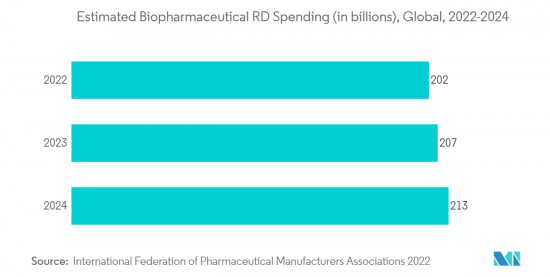PUBLISHER: Mordor Intelligence | PRODUCT CODE: 1404405

PUBLISHER: Mordor Intelligence | PRODUCT CODE: 1404405
Cell Dissociation - Market Share Analysis, Industry Trends & Statistics, Growth Forecasts 2024 - 2029

The cell dissociation market is valued at USD 0.53 billion in 2024 and is expected to reach USD 1.08 billion by 2029, registering a CAGR of 15.17% over the forecast period (2024-2029).
The COVID-19 pandemic had a significant impact on the market studied. As most pharmaceutical companies focused on therapeutics for COVID-19 infection, the production of cell dissociation enzymes decreased significantly during the pandemic. However, the market has reached its pre-pandemic nature and is expected to witness strong growth over the forecast period.
Key factors responsible for the market growth include increasing R&D activities in biopharmaceutical companies and favorable funding for cancer research globally.
The increase in research and development spending in the biopharmaceutical sector aided in the market's growth. For example, according to 'The Pharmaceutical Industry and Global Health Facts and Figures 2021' published by the International Federation of Pharmaceutical Manufacturers & Associations, the annual research and development spending of the biopharmaceutical industry has been 7.3 times greater than that of the aerospace and defense, industries, 6.5 times more than that the chemicals industry, and 1.5 times more than that of the software and computer services industry. The report further stated that in, 2022 over USD 202 billion was estimated to be spent worldwide on biopharmaceutical research and development. Hence, with strong investments in R&D activities and a pipeline of therapeutics under development, cell dissociation is expected to grow significantly.
Various companies are investing in the research and development of biopharmaceuticals. For instance, in September 2022, Marinus Pharmaceuticals exercised the first contract option by the Biomedical Advanced Research and Development Authority (BARDA) valued at approximately USD 12.3 million, to support the United States onshoring of the manufacturing capabilities for ganaxolone. Furthermore, the new investments in the research and development of biologics by the major market players increase the research activity in producing new biologics. They are expected to drive the market to grow. For instance, in September 2022, Novartis invested in next-generation biotherapeutics to grow its biologics manufacturing and development operations. Hence, with huge R&D investments, the market studied is expected to grow strongly in the coming years.
However, the high cost of tissue- and cell-based procedures is expected to restrain the market growth over the forecast period.
Cell Dissociation Market Trends
Pharmaceutical and Biotechnology Companies Segment is Expected to Witness a Healthy Growth Over the Forecast Period
The increasing focus of biopharmaceutical companies on new drug development and increasing R&D is augmenting the demand for cell dissociation across such companies.
In recent years, there has been a growing demand for biopharmaceuticals due to surging cases of cancer and other life-threatening diseases. There has been a rise in the demand for targeted therapies in recent years. For instance, an article by Pharmaceutical Technology, updated in August 2021, indicated that innovative, novel biologics help in the growth of the biopharmaceutical market, as improved processes and technological developments are aiding in changing the future of manufacturing. Manufacturers of biosimilars are offering less expensive alternatives to many of the monoclonal antibody medications that generate the most revenue in the market at reduced clinical and R&D expenditures.
Also, an article from PubMed published in March 2022 indicated an increase in the demand for biopharmaceuticals, which had prompted the emergence of a business model called 'contract development manufacturing organization (CDMO)' that aids in the development and manufacturing processes. The CDMOs could efficiently manufacture larger volumes of the required biopharmaceutical product, meeting the increasing demands.
Thus, owing to these factors, the segment is expected to grow significantly over the forecast period.
North America is Expected to Hold Significant Share of the Market
Cell Dissociation Industry Overview
Additional Benefits:
TABLE OF CONTENTS
1 INTRODUCTION
- 1.1 Study Assumptions and Market Definition
- 1.2 Scope of the Study
2 RESEARCH METHODOLOGY
3 EXECUTIVE SUMMARY
4 MARKET DYNAMICS
- 4.1 Market Overview
- 4.2 Market Drivers
- 4.2.1 Increasing R&D Activities in Biopharmaceutical Companies
- 4.2.2 Favourable Funding Scenario for Cancer Research
5 MARKET SEGMENTATION
6 COMPETITIVE LANDSCAPE
7 MARKET OPPORTUNITIES AND FUTURE TRENDS





